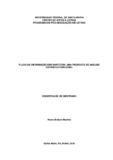| dc.creator | Martins, Noara Bolzan | |
| dc.date.accessioned | 2016-11-22 | |
| dc.date.available | 2016-11-22 | |
| dc.date.issued | 2015-02-23 | |
| dc.identifier.citation | MARTINS, Noara Bolzan. FLOW OF INFORMATION IN FANFICTION: A PROPOSAL OF SYSTEMIC FUNCTIONAL ANALYSIS. 2015. 114 f. Dissertação (Mestrado em Letras) - Universidade Federal de Santa Maria, Santa Maria, 2015. | por |
| dc.identifier.uri | http://repositorio.ufsm.br/handle/1/9931 | |
| dc.description.abstract | The theoretical perspective adopted in this study is part of a systemic-functionalist view of language. The language can be analyzed from different angles, as the postulates of Systemic Functional Grammar (SFG), which considers the texts with metafunciont encompassing ideational, interpersonal and textual meanings. The textual metafunction organizes the language in a unit of meaning (HALLIDAY; MATTHIESSEN, 2004, 2014) that allows us to recognize how we build the flow of information in texts. On the internet, a range of publications explodes daily and we realized many new textual genres arising from the heavy use of technologies and their interference in daily communication activities. Among these new genres are the fanfiction. In this sense, the objective of this study focuses on analyzing how to process the flow of textual information in fanfiction, that is, how we can build these texts as a unit of meaning. The texts are written in portuguese and published in the two largest sites of fanfiction publications in Brazil. The results show that the functional units of amusement - Theme occur mainly at the level of the clause and that the boundary between the subject and the Rheme is located immediately after the first phrasal element with a representation or representational function. The notion of theme, initially equated in terms of the clause, can provide valuable input for the analysis of textual structures. The results also show that in each phase of the text, there may be different sets of semantic topics and N-Rheme, which is essential stages of progression in the textual and therefore all the texts. We consider Theme and N-Rheme as important elements for the analysis above surfaces of sentence - in particular the thematic and rhemetic progression and development, and in general, the construction of textual structure. | eng |
| dc.description.sponsorship | Coordenação de Aperfeiçoamento de Pessoal de Nível Superior | |
| dc.format | application/pdf | por |
| dc.language | por | por |
| dc.publisher | Universidade Federal de Santa Maria | por |
| dc.rights | Acesso Aberto | por |
| dc.subject | GSF - metafunção textual | por |
| dc.subject | Fluxo de informação | por |
| dc.subject | Progressão temática e remática | por |
| dc.subject | Estágios textuais | por |
| dc.subject | Fanfiction | por |
| dc.subject | SFG - textual metafunction | eng |
| dc.subject | Flow of information | eng |
| dc.subject | Thematic and rhemetic progression | eng |
| dc.subject | Textual stages | eng |
| dc.subject | Fanfiction | eng |
| dc.title | Fluxo de informação em fanfiction: uma proposta de análise sistêmico-funcional | por |
| dc.title.alternative | Flow of information in fanfiction: a proposal of systemic functional analysis | eng |
| dc.type | Dissertação | por |
| dc.description.resumo | A perspectiva teórica adotada neste estudo insere-se numa visão sistêmico-funcionalista da linguagem. A linguagem pode ser analisada de diferentes ângulos, conforme os postulados da Gramática Sistêmico-Funcional (GFS), que considera os textos como construções metafuncionais que englobam complexos de significados ideacionais, interpessoais e textuais. A metafunção textual organiza a linguagem em uma unidade de sentido (HALLIDAY; MATTHIESSEN, 2004) que permite averiguar de que forma se constrói o fluxo de informação em textos. Na internet, uma gama de publicações explode diariamente e percebemos muitos gêneros textuais novos advindos do intenso uso das tecnologias e suas interferências nas atividades comunicativas diárias. Dentre esses novos gêneros estão as chamadas fanfictions. Nesse sentido o objetivo deste estudo concentra-se em analisar como se processa o fluxo de informação textual de fanfictions, ou seja, a forma como se constroem esses textos como unidade de sentido. Os textos são escritos em língua portuguesa e publicados nos dois maiores sites de publicações de fanfictions do Brasil. Os resultados mostram que as unidades funcionais Tema-Rema se manifestam principalmente ao nível da oração e que a fronteira entre o Tema e o Rema se situa imediatamente após o primeiro elemento frásico com uma função ideacional ou de representação. A noção de Tema, inicialmente equacionada ao nível da oração, pode fornecer elementos válidos para a análise de estruturas textuais. Os resultados mostram ainda que, em cada estágio do texto, é possível haver distintos conjuntos semânticos de Temas e N-Remas oracionais, o que é determinante na progressão textual dos estágios e, por conseguinte, da globalidade dos textos. Consideramos os Temas oracionais e a análise do conjunto de N-Rema como elementos importantes para a análise de diversas dimensões acima da oração designadamente a progressão e o desenvolvimento temáticos e remáticos e, de um modo geral, a construção da estrutura textual. | por |
| dc.contributor.advisor1 | Cabral, Sara Regina Scotta | |
| dc.contributor.advisor1Lattes | http://buscatextual.cnpq.br/buscatextual/visualizacv.do?id=K4735272P3 | por |
| dc.contributor.referee1 | Olioni, Raymundo da Costa | |
| dc.contributor.referee1Lattes | http://lattes.cnpq.br/0286268226169422 | por |
| dc.contributor.referee2 | Bortoluzzi, Valeria Iensen | |
| dc.contributor.referee2Lattes | http://buscatextual.cnpq.br/buscatextual/visualizacv.do?id=K4708043A6 | por |
| dc.creator.Lattes | http://lattes.cnpq.br/6066576596923729 | por |
| dc.publisher.country | BR | por |
| dc.publisher.department | Letras | por |
| dc.publisher.initials | UFSM | por |
| dc.publisher.program | Programa de Pós-Graduação em Letras | por |
| dc.subject.cnpq | CNPQ::LINGUISTICA, LETRAS E ARTES::LETRAS | por |


